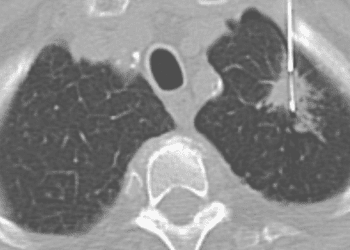2 Minute Medicine Rewind July 22, 2024
1. In a retrospective cohort study of women newly diagnosed with breast cancer, use of hormone therapy was associated with a decreased risk of developing ADRD, especially in Black women and women younger than 75 years old.
Evidence Rating Level: 2 (Good)
Breast cancer is one of the most common cancer diagnoses in the United States and is the most common among women. One significant non-modifiable risk factor for developing cancer is age and the majority of breast cancer cases (83%) are found in women 50 years or older. Many new patients are receiving diagnoses of Alzheimer’s Disease (AD) along with an increase in AD and related dementia (ADRD). Since there are more breast cancer survivors, there is a concern about developing ADRD in this population. Some common treatments for breast cancer include chemotherapy, hormone-modulating therapy (HMT), radiation, and surgery. A prospective cohort study was conducted. This prospective cohort study aimed to investigate the association between HMT use and the risk of ADRD in new breast cancer cases. Among 18 808 women who met the inclusion criteria, 12 356 of them (65.7%) were exposed to HMT at some point in the first three years since their diagnosis whereas 6452 (34.3%) had no exposure. Within the population, 2926 (23.7%) and 1802 (27.9%) of HMT and non-HMT users respectively developed ADRD. Death resulted in 3262 (26.4%) patients in the HMT group and 1776 (27.5%) patients in the non-HMT group. The risk of developing ADRD significantly decreased in those taking HMT (HR, 0.93; 95% CI, 0.88-0.98; P=.005). There was a 7% lower relative risk associated with ADRD (HR, 0.93; 95% CI, 0.88-0.98; P=.005). After the first set of analyses, the participants were divided into two groups based on age (65-74 years and ≥75 years) to assess further the relationship between age, race and ADRD risk. Among Black women, those in the age group between 65 to 74 years had a significantly reduced risk of developing ADRD (HR, 0.76; 95% CI, 0.62-0.92). Similarly, among white women, those in the same age group (65-74 years) also had a risk reduction of 11% (HR, 0.89; 95% CI, 0.81-0.97) however there was no association in women 75 years or older (HR, 0.96; 95% CI, 0.90-1.02). In summary, HMT was associated with a risk reduction in developing ADRD among women aged 65 or older who were recently diagnosed with breast cancer.
1. In this cohort study, majority of the participants did not use all of the opioids prescribed to them in the emergency department (ED) implicating that doctors working in the ED can lower the number of opioids prescribed.
Evidence Rating Level: 1 (Excellent)
In 2020, tens of thousands of people died from opioid overdoses in the United States while some other few thousand died in Canada in 2021, with numbers expected to rise in both countries. The emergency department has played a large role in providing individuals with opioids, and among the individuals that received their first opioids from a legal prescription, 20% were prescribed in the emergency department. The purpose of this study was to understand the prime dose for an opioid prescription that will decrease the patient’s pain while limiting the quantity of opioids prescribed in the emergency department. Recruitment took place between May 2019 and January 2023 with a pause between March to October 2020 due to the COVID-19 pandemic. The patients responded to a questionnaire for demographics and recorded their pain medication intake into a diary for 14 days. Research assistants also interviewed the participants over the phone to ensure complete data collection. All of these methods were used to evaluate the main outcome, quantity of opioid tablets consumed during the 14-day follow-up period. To match up all the opioids into the same measurements for comparison purposes, each prescription was converted into morphine 5 mg tablet equivalents. After screening, 2240 participants, with a mean age 51 (SD ± 16) years were included. During the follow-up period, majority (93%; n = 2074) of the patients filled their prescribed opioid medication, and overall reported using a median number of 5 morphine 5 mg tablet equivalents. The pain levels varied depending on the condition (p<0.001) with the lowest pain reported in patients with renal colic or abdominal pain, while the highest pain was reported in patients with musculoskeletal pain. In total, 63% of the prescribed opioids were unused among the 2240 patients. Overall, the number of opioids needed varied for different conditions, although majority of the patients had a low (5 morphine 5 mg tablet equivalent) use of opioids in general. These results can help physicians lower the amount of opioids they prescribe, while still ensuring their patient’s pain is well managed.
1. In a cohort of infants born to mothers during the COVID-19 pandemic, neither vaccination nor infection with COVID-19 led to increased risk of any congenital anomaly.
Evidence Rating Level: 1 (Excellent)
There is an increased risk of pregnancy complications in women who contract COVID-19 while pregnant. As a result, it is highly recommended that pregnant women get vaccinated against COVID-19 to prevent transmission. Since there are not many past studies on the effects of vaccinations during pregnancy, these researchers attempted to understand the risk of the fetus developing congenital anomalies from exposure to COVID-19 (whether through the vaccination or infection) during the first trimester. This prospective-based study included 343 066 liveborn singleton births in Sweden, Denmark, and Norway with an estimated pregnancy start time between March 1, 2020, and February 14, 2022. Covid-19 vaccination, and infection were used as two separate exposures. Major congenital anomalies were defined according to the EUROCAT (European Surveillance of Congenital Anomalies) classification. The analyses were done separately for each country and then combined using a random effects meta-analysis. Among the infants in the study, 17,704 received a diagnosis of a major congenital anomaly, and 737 of those infants (4.2%) had anomalies in multiple subgroups. Only 3% (10 299) of the infants had mothers who got a COVID-19 infection during the first trimester. Common trends seen in these women include higher parity, lower educational level, lower household income, and born in the Middle East or Africa. Ultimately there was not an increased risk of developing any major congenital anomalies after the mother had a COVID-19 infection (odds ratio [OR] 0.96; 95% confidence interval [CI] 0.87 to 1.05). Similarly, there was no increased risk of having any congenital anomalies in infants whose mothers were vaccinated in the first trimester (OR, 1.03; 95% CI 0.97 to 1.09). Further assessment showed adjusted ranges from the lowest of 0.84 (0.31 to 2.31) for nervous system anomalies to the highest of 1.69 (0.76 to 3.78) for abdominal wall defects. Maternal vaccination or infection with COVID-19 did not lead to an increased risk of any major congenital anomalies in their infants.
Healthy prenatal dietary pattern and offspring autism
1. The data from two cohort studies show that the chances of receiving an autism diagnosis was decreased in mothers who had a higher adherence to a healthy prenatal dietary pattern (HPDP) compared to mothers who had low adherence to a HPDP.
Evidence Rating Level: 1 (Excellent)
Autism spectrum disorder includes a spectrum of characteristics related to neurodevelopmental conditions such as lack of eye contact and differences responding in social situations. Previous studies have mainly focused on specific nutrient intake (such as folic acid) and their relationship to autism diagnosis, therefore leaving a gap in the literature regarding the relationship between an overall healthy prenatal diet and autism diagnosis. The MoBa used the 40-item Social Communication Questionnaire (SCQ) to assess autism-associated behaviour and communication difficulties, while the ALSPAC used the 12-item Social and Communication Disorders Checklist (SCDC). Adherence to a healthy prenatal dietary pattern (HPDP) was split into low, medium, and high adherence with healthy foods being the ones that are encouraged during pregnancy in respect to dietary guidelines worldwide (such as fruits, vegetables, whole grains, and nuts). To acquire further evidence on the association between adherence of a healthy prenatal diet with autism diagnosis and related traits, the Norwegian Mother, Father and Child Cohort Study (MoBa) and the Avon Longitudinal Study of Parents and Children (ALSPAC) were created. Since two studies were created, they each included different numbers of participants with different data. In total there were 84548 pregnancies (mean [SD] age, 30.2 [4.6] years) in MoBa while there were only 11760 pregnancies (mean [SD] age, 27.9 [4.7] years) in ALSPAC. After the models were adjusted, mothers with a higher adherence to a healthy diet was associated with a decreased odds of the offspring receiving a diagnosis of autism, compared with mothers with a low adherence (OR, 0.78; 95% CI, 0.66-0.92). Similarly, high adherence was also associated with a decreased odds of the offspring having difficulties communicating at 3 years old according to MoBa (OR, 0.76, 95% CI, 0.70-0.82) and 8 years old according to ALSPAC (OR, 0.74; 95% CI, 0.55-0.98). Both the MoBa and the ALSPAC found that the mothers who had a higher adherence to a HPDP had a 22% decreased odds of their child receiving an autism diagnosis.
1. A population-based cohort study showed that there was a significant association between high dietary sugar content and an increased risk of developing dementia.
Evidence Rating Level: 1 (Excellent)
Dementia is increasing rapidly around the world and is a serious public health concern. Although some progress has been made regarding treatment targeting amyloid-related pathologies, there are still steps that must be taken. Many past studies have emphasized the role of diet in preventing dementia, specifically focusing on sugar-sweetened beverages (SSBs), however, there was a lack of research focusing on dietary sugar intake. Seeing the literature gap, these researchers decided to understand the association between sugar intake and dementia risk. Data was taken from the UK Biobank database, which included a prospective cohort of 210 832 individuals. The participants filled out on online questionnaire providing information about their sugar intake from foods and beverages in the past 24 hours. Dividing the total sugar intake by the total energy intake (unit: kJ) led to the result of relative sugar intake (unit: %g/kJ/day). All-cause dementia was the outcome of focus, with secondary outcome including Alzheimer’s Disease (AD). Of the participants, the individuals most likely to consume higher levels of sugar were males, current smokers, and participants with vascular diseases. There was a statistically significant association between a greater sugar intake (g/day) and all-cause dementia (HR=1.003, [95%. CI: 1.002-1.004], p<0.001) and AD (1.002, [1.001-1.004], 0.005). Similarly, there was a significant association between regular sugar intake and a greater risk of dementia (1.317, [1.173-1.480], p<0.001) and AD (1.249 [1.041-1.500], 0.017). High sugar intake was associated only with a higher risk of all-cause dementia (1.090, [1.045-1.136], p<0.001). The relationships between all-cause dementia and Alzheimer’s Disease, and sugar intake and high-sugar intake, produced non-linear relationships (p values for non-linearity < 0.05). Overall, study findings provide strong evidence for an association between dietary sugar intake and dementia risk, and may be used to inform discussions between healthcare practitioners and at risk geriatric populations.
Image: PD
©2024 2 Minute Medicine, Inc. All rights reserved. No works may be reproduced without expressed written consent from 2 Minute Medicine, Inc. Inquire about licensing here. No article should be construed as medical advice and is not intended as such by the authors or by 2 Minute Medicine, Inc.







